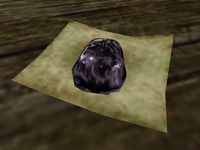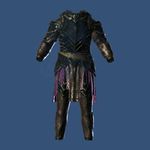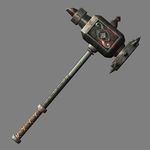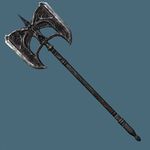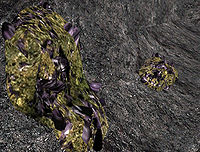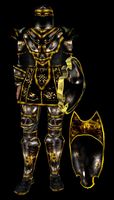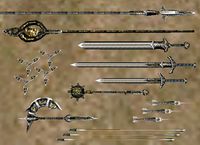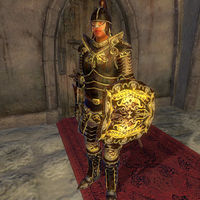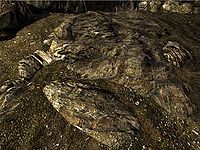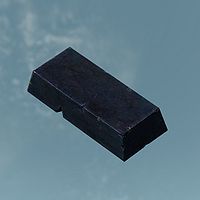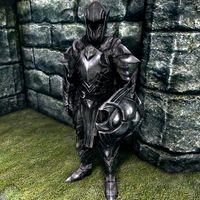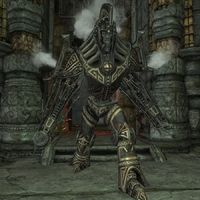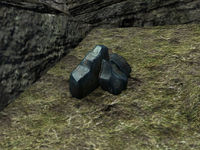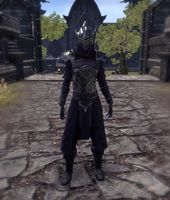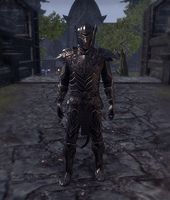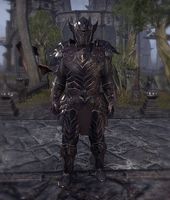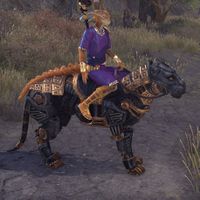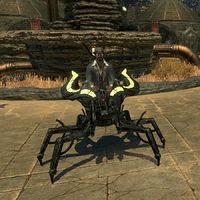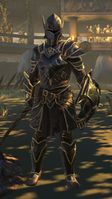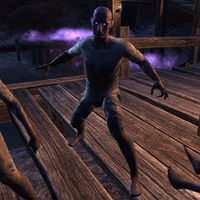Lore:Ebony
Ebony, a rare volcanic glass,[1] is one of the most precious substances in Tamriel, mainly found in Vvardenfell, buried in the lava flows from Red Mountain.[2] Veins can also be found in Solstheim, and occasionally on mainland Skyrim, Cyrodiil and High Rock.[3][4] Raw ebony itself is an extremely hard, durable, black glass-like substance.[2] It is also known as Godsblood,[5] as it is said to be the crystallized blood of a god or gods,[6][7] Lorkhan in particular.[1][8][9] The acquisition and use of ebony can lead mortals to transcend their limitations.[9]
The ore has several alchemical properties[10] and is often smelted into ebony ingots for use in smithing.[11] The process of refining the ore takes six months, but the process could be sped up to only a few days with the aid of a convection oven that is stoked by white magical flames. Ebony armor is made by repeatedly folding the ore upon itself to form strips, which are then molded into shape.[12] This creates a durable, heavy armor. Ebony weapons are also highly prized. Smiths who can work with ebony are called ebonysmiths.[13] Daedric armor and weapons are created from ebony, by imbuing the object with the magical substances of Lesser Daedra, in a process known only to the denizens of Oblivion. It has been claimed that exceptionally skilled smiths can create Daedric armor by throwing a Daedric heart into melted ebony under a lunar phenomenon, with the harvest moon being the best time to do so.[14]
According to pre-ri'Datta Khajiiti myths, after the events of Convention resulted in his organic heart being removed, Namiira filled the hole where Lorkhaj's heart used to be, and kept him alive as a perverted imitation of his heart. Knowing that Namiira would overcome him, Lorkhaj fled to his sister Azurah, who cleansed him of his corruption, and flung the Dark Heart into the Void, and Lorkhaj perished within Azurah's embrace.[15][16] Azurah had observed the Dark Heart beating like a drum, with each heartbeat spewing "black blood" (ebony) that tapped the floor to form a rhythm.[15] The spirit Noctra was later born of this black blood at the steps of the Void Gate.[16] The spirit Boethra created the Ebony Mail out of this substance, which functions as the "death-shroud of Lorkhaj", which she wears on nights of the Ghost Moon, and "wages war beyond the Lattice".[17]
According to Nordic myth, Ysgramor cried tears of pure ebony as he watched the city Saarthal burn. His son Yngol collected the tears and used them to forge Wuuthrad, his legendary battleaxe.[18] Molag Bal's Dark Anchors are made of ebony-alloy cold-iron, which is smithed by Dremora in the Black Forge.[19][20]
The Dunmer are said to have learned to forge Ebony back in "Boethiah's day".[5] The curves featured in Ebony weaponry emulate the Dunmeri style.[21]:161 Vivec is said to have once sealed a temple with a seamless plane of ebony.[UOL 1]
The association with Lorkhan's blood reaches various cultures. The term "Shor's blood" is commonly used by Nords to exclaim surprise,[22] though the Breton equivalent is the phrase "Sheor's blood".[23] The town of Shor's Stone is evidently named after Shor, and is known for its ebony mine, where miners harvest the blood of Shor.[24] Some Nords believe Nirncrux to also be the blood of Shor.[25]
Tiber Septim coveted the vast source of Ebony in Morrowind, leading to it being one of the main reasons for his decision to invade it.[26] Sometime after the signing of the Armistice, it was protected by Imperial law during the Third Empire, and could not be mined or exported without an Imperial charter.[2] The East Empire Company essentially became the sole authority to trade in raw ebony.[27]
The Dwemer used ebony, and ebony-steel alloys for constructing certain animunculi and vamidiums.[28][29][30]
The Vassir-Didanat Ebony Mine in the Ascadian Isles region of Vvardenfell had changed ownership over the years.when A barely kept secret is its source of Ebony, which is mostly lackluster, but just enough to be worth mining. Unsatisfied, one of the previous owners of the mine turned to Clavicus Vile, and erected a shrine within its interior. They made a deal with the Prince of Bargains, requesting a limitless supply of Ebony, and Vile provided them a formula for them to do so.[31] This substance, dubbed "False Ebony", looks and feels like real Ebony, but can be told apart by a skilled craftsman.[32]
Orc followers of Trinimac use Ebony as a material for their armors and weapons in token of Lorkhan's blood when Trinimac tore out his heart. They believe that Zylvara, the great eagle bore the Golden Champion to his reckoning with the man-demon Quarvish.[33]
Contents
Artifacts[edit]
A number of artifacts are made of Ebony, and Ebony has been used to improve or temper the quality of various artifacts.[11] Sometimes an artifact has appeared as made out of Ebony, but has also appeared at other times made from a different material.
Dragon's Tooth[edit]
The Dragon's Tooth (or simply Tooth) is a mythical ebony dagger with a hilt made from a dragon's tooth, hence the name. The hilt is intricately carved with intertwining roses, thorns, and leaves, in line with the black rose symbology tied with Morrowind and the Ra'athim Clan of Ebonheart. It is also described as having a "wicked point" and a sharp edge you can even shave with. The tooth came from the dragon who roosted in Fang Lair. In the historical-fiction series, King Edward, they were known as Akatosh, the Lord of the Dragons but based on historical information, they were known as Thurvokun. It is mainly associated with the two legendary heroes, Kings Moraelyn and Edward, who took in the dragon as one of their companions.
Ebony Blade[edit]
The Ebony Blade, also known as the Vampire or the Leech, is a Daedric artifact created by the Daedric Prince Mephala. It resembles an ebony katana, and is considered to be an artifact of great evil, having the ability to absorb the life essence of those that it strikes. Part of the damage inflicted flows into the wielder as raw power, draining the victim of their health and sometimes stamina. It has also been known to fortify the wielder's skill at using long blades, magically silence those that it strikes to prevent them from casting spells, and deceive victims. Khajiiti myths do not mention the blade by name, but instead refer to it as 'the killing word of the Spider' and 'the black edge of shadow'.
Ebony Mail[edit]
The Ebony Mail is a Daedric artifact created by the Daedric Prince Boethiah. In appearance it looks like an ebony suit of armor, or often simply a cuirass. It can either be medium or heavy in weight. The artifact grants its wearer resistance to fire and magical attacks, magical protection from physical blows, quieter movements and the ability to poison enemies who get too close. The artifact was created before recorded history by Boethiah, and it is Boethiah alone who determines who should possess the Mail and for how long a time.
Mehrunes' Razor[edit]
Mehrunes' Razor (sometimes Mehrunes Razor), also called the Dagger of the Final Wounds, the Bane of the Righteous, and the Kingslayer, is a Daedric artifact created by the Daedric Prince Mehrunes Dagon. This powerful ebony dagger has the ability to kill instantly, as there is a small chance that Dagon will claim the souls of those struck by the Razor. It is Daedric in appearance, emblazoned with Daedric script and seemingly able to drink the light that hits it.
Scourge[edit]
Scourge (also known as Mackkan's Hammer, Bane of Daedra, the Daedric Scourge, or Scourge, Blessed of Malacath) is a legendary Daedric artifact. It was forged from sacred ebony in the Fires (or Fountains) of Fickledire, and is associated with Malacath. It is a fierce weapon, and takes the form of a steel or ebony mace. Malacath dedicated it to mortals, and any Daedra who attempts to invoke its power will be sucked into a voidhole and banished to the Outer Darkness of Oblivion's voidstreams. It also has the ability to banish them to Oblivion with a single blow, and can summon Daedra such as Dremora and Scamps from Oblivion to do the wielder's bidding. The summons are said to be those that it has previously "killed", and its victims are said to be poisoned. It has been described as a "bold defender of the friendless", which could be related to Malacath's role as the Daedric Prince of outcasts.
Stendarr's Hammer[edit]
Stendarr's Hammer is a hammer rumored to have once been wielded by Stendarr, the God of Justice. One of his other titles, the God of Righteous Might, is fitting as the hammer is very heavy. It is made of ebony and sapphire, which can also be used to further temper it The weapon is enchanted to drain or damage the health of those it strikes, at the cost of the wielder's stamina.
Wuuthrad[edit]
Wuuthrad, meaning "Storm's Tears" in the language of Atmora, was the legendary battleaxe wielded by Ysgramor during his conquest of Skyrim in the late Merethic Era. With Wuuthrad in his hands, Ysgramor and his Five Hundred Companions slaughtered an untold number of elves, which culminated in the founding of the First Empire of the Nords. For the Companions, Wuuthrad is a sacred relic which holds a great deal of respect and reverence, and through it they can trace their line straight back to the first Harbinger. It is held to be the greatest of all Nord weapons.
Notes[edit]
- The Amulet of Kings is made from Lorkhan's blood infused with Magicka, and is red unlike Ebony's black color.[34]
- In real life, ebony is a type of hard, black wood, traditionally used to make piano keys and other such items. This is in no way related to the ebony in The Elder Scrolls series, which is a volcanic glass. A closer equivalent in real life would be obsidian, though ebony's use in making armor and weapons suggest that it is far tougher and more malleable than obsidian, which is hard and brittle. The mention of "folding" when smithing it lends evidence that it may be some manner of metallic glass.
Gallery[edit]
See Also[edit]
- For game-specific information, see the Morrowind, Skyrim, Elder Scrolls Online, and Blades articles.
References[edit]
- ^ a b Ebony Ingot description in Blades
- ^ a b c Items Codex on elderscrolls.com
- ^ Red Ruby Cave loading screen in ESO
- ^ Koeglin Mine loading screen in ESO
- ^ a b Interview with a Dark Elf
- ^ Morrowind dialogue
- ^ Hrorvild Blackrock, Nord weaponsmith — Hrorvild Blackrock
- ^ Crafting Motif 22: Trinimac Style — the Venerable Uugus, Priest of Trinimac
- ^ a b Divayth Fyr Answers Your Questions — Divayth Fyr
- ^ Morrowind ingredient effects
- ^ a b Smithing in Skyrim
- ^ The Armorer's Challenge — Mymophonus
- ^ Ebonysmith + silversmith's greeting dialogue in Arena
- ^ Heavy Armor Forging — Sven Two-Hammers
- ^ a b The Favored Daughter of Fadomai — Amun-dro, the Silent Priest
- ^ a b The Dark Spirits — Amun-dro, the Silent Priest
- ^ The Wandering Spirits — Amun-dro, the Silent Priest
- ^ Songs of the Return, Volume 5
- ^ The Black Forge loading screen
- ^ The Black Forge — Kyngald Nazkrixor
- ^ The Art of Skyrim
- ^ Gekurek, Friga Bearfist, and a plethora of other Nords using "Shor's blood" as an exclamation in ESO
- ^ Ludovic Laumont's dialogue in ESO
- ^ Shor's Stone loading screen in ESO
- ^ Rena Hammerhands' dialogue in ESO
- ^ The Arcturian Heresy — The Underking, Ysmir Kingmaker
- ^ Carnius Magius' dialogue in Morrowind: Bloodmoon
- ^ Vitrine Dwarven Horse mount in ESO
- ^ Ebon Dwarven Senche mount in ESO
- ^ The Messenger in Skyrim
- ^ The Source of the Formula — Gavros
- ^ Gavros's Journal — Gavros
- ^ Crafting Motif 22: Trinimac Style — the Venerable Uugus, Priest of Trinimac
- ^ Chim-el Adabal: A Ballad
- ^ Ebony Wood Musical Calliope item description in ESO
- ^ Heartwood furnishing material in ESO
Note: The following references are considered to be unofficial sources. They are included to round off this article and may not be authoritative or conclusive.
